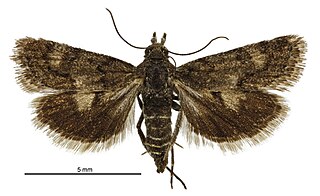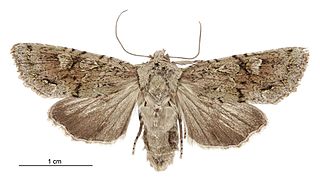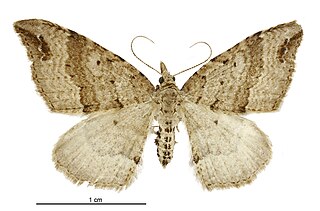
Clanidopsis is a genus of moths in the family Sphingidae, containing only one species Clanidopsis exusta, the white-streaked hawkmoth. The genus was erected by Walter Rothschild and Karl Jordan in 1903 and the species was first described by Arthur Gardiner Butler in 1875.

Ercheia dubia is a species of moth of the family Erebidae first described by Arthur Gardiner Butler in 1874. It is found in Asia and in Australia and New Guinea

Izatha huttonii is a moth of the family Oecophoridae. It is endemic to New Zealand, where it is known from the Wellington district of the North Island, the South Island, and Stewart Island. Although similar in appearance to related species I. huttonii can be distinguished as it has a distinctive M-shaped mark on its forewings. The larvae feed on the dead wood of makomako and karamu. Adult moths have been collected from October to March.
Cosmosoma elegans is a species of moth of the family Erebidae. It was described by Arthur Gardiner Butler in 1876. It is found in Espírito Santo, Brazil.
Mpanjaka grandidieri is a moth of the family Erebidae first described by Arthur Gardiner Butler in 1882. It is found in central Madagascar.
Mpanjaka pastor is a moth of the family Erebidae first described by Arthur Gardiner Butler in 1882. It is found in central Madagascar.

Asaphodes aegrota is a species of moth in the family Geometridae. It was first described by Arthur Gardiner Butler in 1879 as Selidosema aegrota. It is endemic to New Zealand and can be found in the North, South and Stewart Islands. This species inhabits open spaces in lowland native forest. The larvae of A. aegrota feed on native herbs and have also been observed feeding of the introduced lawn daisy. The adults are variable in appearance with the markings on both sides of its wings varying in intensity. Some populations also have narrow winged females. Adults are on the wing from November until March.
Cosmosoma batesii is a moth of the family Erebidae. It was described by Arthur Gardiner Butler in 1876. It is found in the Brazilian states of Pará and São Paulo.
Cosmosoma beata is a moth of the family Erebidae. It was described by Arthur Gardiner Butler in 1876. It is found in Panama, Colombia and Brazil.
Cosmosoma determinata is a moth of the family Erebidae. It was described by Arthur Gardiner Butler in 1876. It is found in Colombia.
Cosmosoma gemmata is a moth of the family Erebidae. It was described by Arthur Gardiner Butler in 1876. It is found in Panama and Colombia.

Cosmosoma salvini is a moth of the subfamily Arctiinae. It was described by Arthur Gardiner Butler in 1876. It is found in Panama and Costa Rica.

Hierodoris atychioides is a moth of the family Oecophoridae. It was described by Arthur Gardiner Butler in 1877. The female holotype specimen held at the Natural History Museum, London. This species is endemic to New Zealand, and can be found in the North, South and Stewart Islands. The larvae form webs of silk attached to frass and leaves on their hosts in which they shelter, often in the company of other larvae in their species. Their feeding habits have not been observed in detail but Hoare hypothesises the larvae may feed on dead or dying leaves. The larvae feed on a wide range of trees and shrubs, including Dacrydium cupressinum, Prumnopitys taxifolia, Dacrycarpus dacrydioides, Libocedrus bidwillii, Cupressus macrocarpa, Leptospermum scoparium, Kunzea ericoides, Ozothamnus leptophyllus, Abies, Picea, Pinus and Thuja species. Although they are regarded as a pest of exotic forests in New Zealand, the economic damage the larvae cause is minimal and they tend to be controlled only by their natural enemies. Larval enemies include the parasitic flies Trigonospila brevifacies and Pales funesta as well as parasitic wasps including Xanthopimpla rhopaloceros. The adult moths are day flying and are most common during the months of December and January. This species is variable in appearance as larvae, pupa and as adults, and it has been hypothesised that it is in the process of speciation.

Heliothela atra is a moth of the family Crambidae. It was described by Arthur Gardiner Butler in 1877. This species is endemic in New Zealand and has been observed in both the North and South Islands. The preferred habitat of this species is dry tussock grasslands and short-sward sites. Adults of this species are on the wing from December until March and are day flying moths known for their rapid flight. This species is said to be associated with Melicytus alpinus.

The Euchromiina are a subtribe of tiger moths in the family Erebidae. It was described by Arthur Gardiner Butler in 1876. Many species in the subtribe are mimics of wasps. Euchromiina have always been considered closely related to the subtribe Ctenuchina due to their similarity to moths and wasps. These two subtribes make up around 3,000 valid species, the majority of which occur in the Neotropics.
Diathrausta picata is a moth in the family Crambidae. It was described by Arthur Gardiner Butler in 1889. It is found in the north-western Himalayas and Australia.
Udea melanosticta is a moth in the family Crambidae. It was described by Arthur Gardiner Butler in 1883. It is found in Chile.
Mnesictena notata is a moth in the family Crambidae. It was described by Arthur Gardiner Butler in 1879. It is endemic to New Zealand.

Ichneutica skelloni is a moth of the family Noctuidae. This species is endemic to New Zealand. Its presence has been confirmed in the North Island only in the Wellington region but is widespread throughout the South Island. It is also found in Stewart Island. I. skelloni is extremely variable in size, in the colour and patterns on the fore and hind wings, length of pectinations on male antennae and even in its genitalia. A larger more patterned form can be found in Westland and Fiordland, a medium-sized form is found from Wellington to Stewart Island and there is also a smaller Dunedin and Southland form. This species can be confused with specimens with the species I. insignis, I. scutata and I. pelanodes. I. skelloni can be found in forest and shrubland habitat. Adults are on the wing from July to April and are attracted to light. Host plants for the larvae are found in the genera Plantago, Senecio and Ranunculus and also include the species Bellis perennis.

Homodotis falcata is a moth of the family Geometridae. It is endemic to New Zealand and is found in the southern part of the South Island. The larvae of this species feed on leaf litter and adults are on the wing for most months of the year. The forewings of this species can vary in depth of colour.










